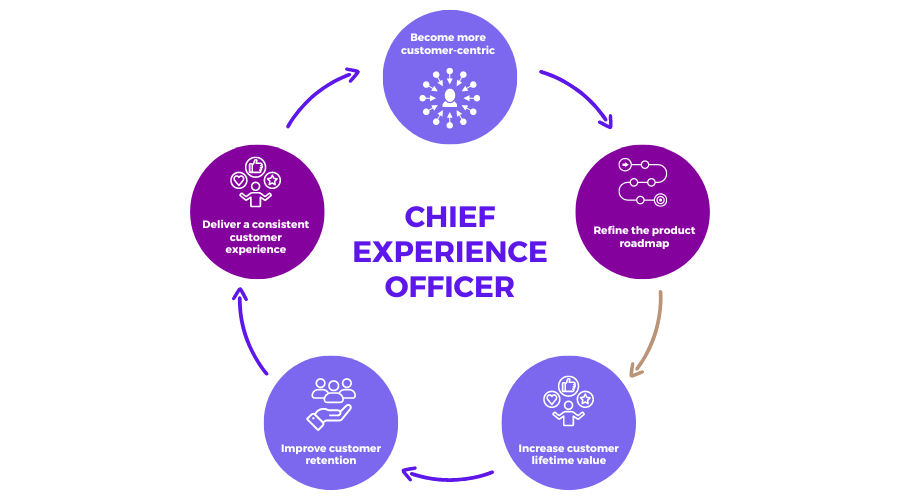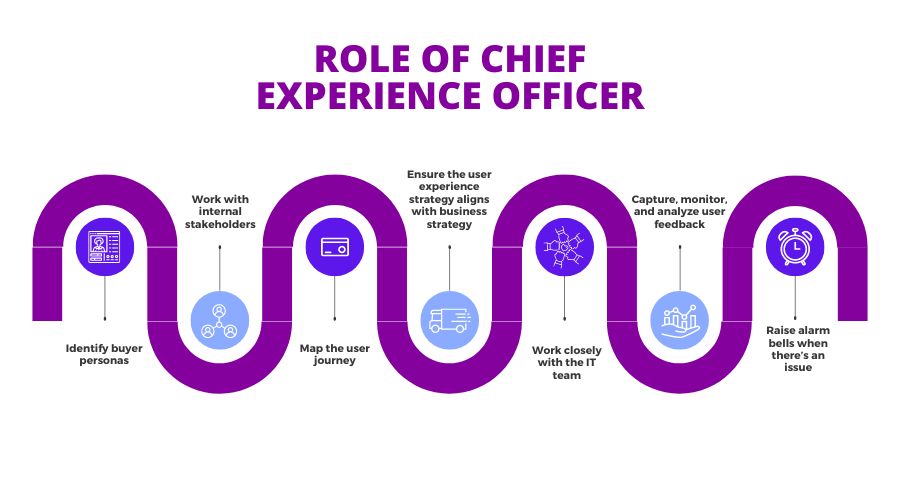
Chief Experience Officer Definition:
A chief experience officer (CXO) is a C-suite executive who ensures that an organization’s clients have a great experience. CXO usually reports back to the Chief executive officer (CEO) and the Chief operating officer (COO) or chief marketing officer (CMO)
What Is a Chief Experience Officer?
A CXO uses customer experience (CX) initiatives to offer differentiated brand experiences that increase customer loyalty and advocacy. Employee experience (EX) ensures that employees exemplify the company’s customer promise and deliver on brand expectations.
More businesses are discovering that establishing seamless, integrated customer journeys is challenging and crucial, and they’re responding by hiring a CXO to lead the charge.
Change management, learning and development, and human resources teams work closely with a CXO. Employees’ grasp of customer happiness and leadership’s feelings about their people and employee satisfaction enhance by this necessary cross-functional teamwork.
We’ve all heard of CEOs, CTOs, CMOs, and even C-3POs, but what about a CXO? As noted above, a Chief Experience Officer is a senior executive responsible for monitoring and improving all user experiences.
Beyond design, what makes a great Chief Experience Officer is the ability to understand the complete start-to-end spectrum of the product design cycle. A CXO combines the world of UX design, technicalities of development, and product management. – David Yap, Co-founder of Zensite UI UX Design Agency.
While a CXO may appear to be a minor function, it is critical to improving a customer’s experience with your product, which assures low churn and high satisfaction and renewal rates.

CXO vs. CMO
Now that we’ve established who the CXO is let me briefly outline the role of the chief marketing officer and how they interact.
A (chief marketing officer) CMO is a C-level corporate head in charge of operations in an organization that involves developing, communicating, and delivering value-added solutions to consumers, clients, and business partners.
The company’s advertising operations, brand management, market research, product creation and management, marketing communications, pricing, and customer support are all expected to be led by the CMO.
The Chief Marketing Officer (CMO) oversees a team of marketing experts and reports to the company’s Chief Executive Officer (CEO).
Today, the CMO’s responsibilities are merging with those of a Client Experience Officer, or CXO, resulting in a complicated new function with numerous moving pieces at all levels and departments of the company. The devil resides in the details when the worlds of the CMO and CXO align or even combine.
To transform the consumer experience, the CMO and CXO must work together.
The challenge in today’s ‘prosumer’ age is that the experiences now establish our brand that our customers have with our brand, not by the messages that we send out into the ether. In other words, we have even less control over our “brand” than we did in the past. Wow, that’s exactly right!
How Many Types of CXO Are There?
Before we can respond, we must first understand another term: corporate title. A corporate title, also known as a business title, refers to organizations and company executives to indicate their roles and responsibilities in organizations such as internet behemoths, small enterprises, and manufacturing firms.
Because there are so many different C-level designations today, they’re all referred to as CxOs.
- Chief Executive Officer (CEO) – The CEO is generally the company’s highest-ranking executive and serves as its public face.
- Chief Financial Officer (CFO)- The function of the Chief Financial Officer (CFO) is to manage, report, and strategize the company’s finances. For anyone in the financial sector wishing to advance, the CFO position symbolizes the pinnacle of the corporate ladder.
- Chief Operating Officer (COO) – The COO is a C-level HR executive who is usually second in command to the CEO.
- CTO (Chief Technology Officer) – Even though they have quite different roles, a CTO and a CIO are sometimes mistaken. Unlike a CIO, a CTO’s job is to adopt and manage technologies within a corporation.
- CAO (Chief Accounting Officer)- The term CAO (Chief Accounting Officer) is becoming increasingly prevalent in the finance industry. The CAO oversees all accounting functions, such as ledger accounts, financial statements, and cost control systems.
There are others in addition to the ones mentioned above.
Why Is a CXO Needed?
Customer and employee experience are currently two of the most critical factors in business and product management.
We cannot talk about product management without mentioning the primary tool that product managers rely on- Chisel.

With the product feedback tool in Chisel, you can get feedback from your target audience. This will help you to make data-driven decisions that will reflect the needs of your customers. All in one package!
The customer experience (CX) is the new marketing, and it impacts brand perceptions and business success as traditional marketing methods like media advertising and price promotions.
A positive customer experience increases a person’s likelihood of recommending a firm and purchasing in the future five times. According to Forrester, 76 percent of executives believe that improving customer experience is a high or essential priority, and many organizations have created a C-level job to supervise it.
Over the last few years, there’s been a drive to merge a Chief Customer Officer’s (a more established term, notably among Fortune 500 companies) exterior customer focus with inside employee experience roles.
The Chief Experience Officer, or CXO, was formed by companies such as PwC, Adobe, Hasbro, and MasterCard. It differs from other C-suite positions in that it combines internal and external-facing activities in ways that benefit customers both directly and indirectly.
More and more businesses are establishing a C-level position committed to fostering a customer-centric culture that integrates customer and employee experience. But does this imply that to compete, every company requires a CXO? What are your thoughts?
What Does a Chief Experience Officer Do?
One of CXO’s main objectives is to constantly improve the company’s relationship with its consumers. With their only emphasis on optimizing the customer journey, the CXO is also responsible for cultivating a customer-centric internal culture. The only way to do so is to put the user at the center of their planning.
The CXO is in charge of ensuring that everyone in the company is on the same page regarding how to provide the most value to the client.
The ideal CXO collaborates closely with marketing, sales, product teams, and the C-suite to achieve the following goals:
- Define what “value” means to customers;
- Create a shared language for discussing the customer experience
- Set their products/services apart from those of their competitors.
- Decide which portions of the consumer base are worth investing in.
CXOs are specialists at generating data-driven customer journey maps and detecting friction points and holes in the buying process that could harm brand perception or lead customers to seek out a competitor.
The CXO must collaborate cross-functionally with various teams across the organization to share data, information, and strategies. Ensuring that all customer-facing groups and messaging follow the same playbook and have a common understanding of what the company does, who all it benefits, and why people should care.

What To Look For in a CXO?
What are the most sought-after executive skills in today’s business world?
A successful CXO should be skilled in the many skills that all influential leaders possess, but they must also have unique characteristics that set them apart from the competition.
One of the essential qualities of a strong leader is the capacity to recognize and handle people’s valuable skills and positive qualities sympathetically.
One of the most formidable talents to learn is communication. Whether organizational or interpersonal, communication is critical to a company’s success. The ideal C-suite candidate influences persuasion and communication skills. The ability to communicate vision, strategy, ideas, and problems is the first step toward implementation.
A C-level executive must grasp how technology affects their company and how to take advantage of it.
Team building necessitates developing relationships, forming consensus, empathy, and an awareness of the strengths and weaknesses of those who make up the eco-system.
You can collaborate and foster a cohesive teamwork culture with the help of seamless product management software like Chisel.
Integrity and a track record of ethical behavior are also highly regarded.
Intelligent people can successfully lead organizations of any size and shape if they have the right abilities and mindset. Some people are born with specific skills, but others need to go through an organized program to learn them.
You may also like:
- A Detailed Comparison of Product Managers vs. Project Managers (vs. Program Managers)
- UX Writing: Definition, Examples and Best Practices
- Chief Product Officer (CPO): Definition, Role, Skills & Salary
- Product Manager: Role Definition and Key Skills for Success in 2021
- What Is a Product Specialist? Definition and Overview
- Product Owner vs. Product Manager: A brief history and the differences
FAQs
Begin the discussion with a small chat, then effortlessly shift to business talk before concluding with a casual conversation.
Make an effort to connect on topics of mutual interest and demonstrate good listening skills.
Most CXOs have sharp brains and search for somebody who can compete intellectually with them.
Be willing to talk about your product at both the micro and macro levels, as CXOs are skilled at seamlessly transitioning from one to the other.
Maintain contact after the meeting by sending information regularly, giving you an advantage over your competition.
According to research, Nearly 90% of companies have a Chief Experience Officer. Many businesses have committed to having a dedicated CXO to continuously improve the customer experience to satisfy their changing needs, reduce consumer faults, and boost customer loyalty.
Mastercard, Under Armour, United Way, and private-jet operator Wheels Up have all named their officers.
No, CXO is not higher than CEO (Chief Executive Officer). The CEO is the main head and highest-ranking executive in a company and is responsible for the overall operations, strategy, and growth of the organization. The CEO reports directly to the board of directors and is considered as the leader of the company.
